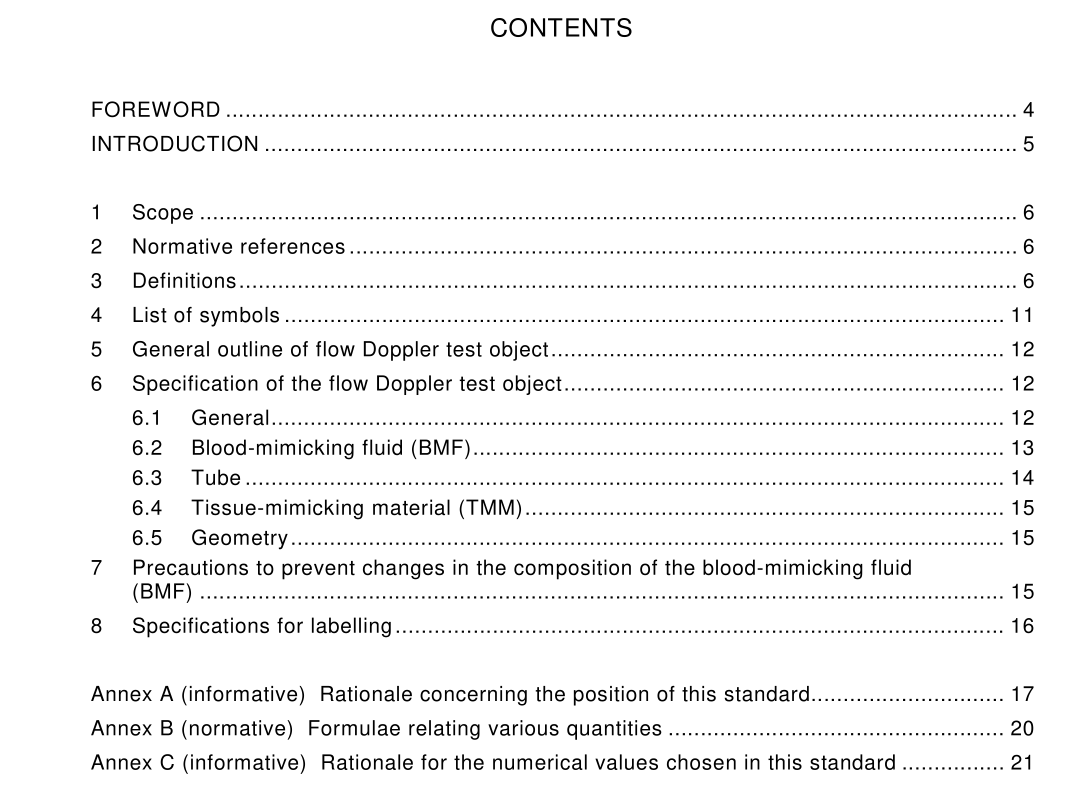IEC 61685 pdf download

IEC 61685 pdf download.Ultrasonics – Flow measurement systems – Flow test object
1 Scope
This International Standard specifies parameters for a flow Doppler test object representing a blood vessel of known diameter at a certain depth in human tissue, carrying a steady flow. This International Standard establishes a flow Doppler test object which can be used to assess various aspects of the performance of Doppler diagnostic equipment.
2 Normative references
The following normative documents contain provisions which, through reference in this text, constitute provisions of this International Standard. For dated references, subsequent amendments to, or revisions of, any of these publications do not apply. However, parties to agreements based on this International Standard are encouraged to investigate the possibility of applying the most recent editions of the normative documents indicated below. For undated references, the latest edition of the normative document referred to applies. Members of IEC and ISO maintain registers of currently valid International Standards. IEC 61 206:1 993, Ultrasonics – Continuous-wave Doppler systems – Test procedures IEC 61 1 02:1 991 , Measurement and characterisation of ultrasonic fields using hydrophones in the frequency range 0,5 MHz to 1 5 MHz IEC 61 895:1 999, Ultrasonics – Pulsed Doppler diagnostic systems – Test procedures to determine performance
3 Definitions
For the purposes of this International Standard, the following definitions apply: 3.1 –3 dB Doppler frequency frequency at which the power per unit frequency in the Doppler spectrum is half (–3 dB) of the maximum value 3.2 –3 dB sample volume volume of a region in space for which the Doppler system gives a response to a point Doppler target that is above –3 dB from the maximal response, taking account of the effects of both transmission and reception Unit: cubic millimetre, mm 3 3.3 –3 dB sample volume length largest dimension of the –3 dB sample volume in the direction of the beam alignment axis (see 3.5 of IEC 61 1 02) Unit: millimetre, mm 3.4 –3 dB sample volume width largest value of the dimension of the –3 dB sample volume along an axis which is perpendicular to the beam alignment axis. In case the Doppler system has a scan plane, the axes are taken in the scan plane and perpendicular to the scan plane Unit: millimetre, mm 3.5 acoustic-working frequency frequency of an acoustic signal based on the output observed by a hydrophone placed in an acoustic field: it is the arithmetic mean of the two frequencies at which the amplitude of the acoustic pressure spectrum is 3 dB below the peak amplitude [conforms to 3.4.2 of IEC 61 1 02] Unit: hertz, Hz 3.6 aliasing false indication of signal frequency as a result of sampling at too low a frequency NOTE The threshold for aliasing depends on pulse repetition frequency and a possible base line shift. 3.7 average frequency of the Doppler spectrum parameter estimated by clinical Doppler systems for the short-time average in a Doppler spectrum, ignoring the contributions from noise NOTE The average frequency of the Doppler spectrum is generally determined for a small time interval, typically 2 ms to 20 ms). Unit: hertz, Hz 3.8 axial response range depth range in tissue over which a signal from a specific target plus noise is at least 3 dB above the noise level [see 2.4.1 of IEC 61 206] Unit: millimetre, mm 3.9 blood-mimicking fluid (BMF) fluid which simulates blood acoustically and is moved at a known flow rate through the flow Doppler test object 3.1 0 channel separation ratio of the signal level in the signal channel corresponding to the movement in the test object (the desired output voltage) and the signal level in the opposite channel (the undesired output voltage) NOTE Channel separation is to be quoted in decibels as twenty times the logarithm of the desired output to the undesired output voltage. [see 2.6.1 of IEC 61 206] Unit: decibel, dB









